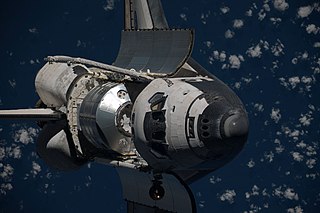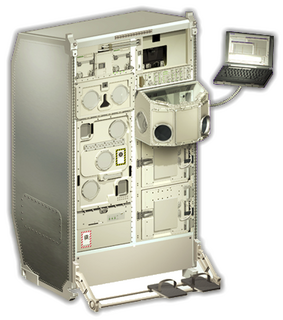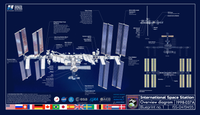
The International Space Station (ISS) is a modular space station in low Earth orbit. It is a multinational collaborative project involving five participating space agencies: Roscosmos (Russia), NASA, JAXA (Japan), ESA (Europe), and CSA (Canada). The ownership and use of the space station is established by intergovernmental treaties and agreements. The station serves as a microgravity and space environment research laboratory in which scientific research is conducted in astrobiology, astronomy, meteorology, physics, and other fields. The ISS is suited for testing the spacecraft systems and equipment required for possible future long-duration missions to the Moon and Mars.

Spacelab was a reusable laboratory developed by ESA and used on certain spaceflights flown by the Space Shuttle. The laboratory comprised multiple components, including a pressurized module, an unpressurized carrier and other related hardware housed in the Shuttle's cargo bay. The components were arranged in various configurations to meet the needs of each spaceflight.

Columbus is a science laboratory that is part of the International Space Station (ISS) and is the largest single contribution to the ISS made by the European Space Agency (ESA).

STS-41 was the eleventh mission of the Space Shuttle Discovery. The four-day mission with a primary objective to launch the Ulysses probe as part of the "International Solar Polar Mission".

STS-96 was a Space Shuttle mission to the International Space Station (ISS) flown by Space Shuttle Discovery, and the first shuttle flight to dock at the International Space Station. The shuttle carried the Spacehab module in the payload, filled with cargo for station outfitting. STS-96 launched from Kennedy Space Center, Florida, on 27 May 1999 at 06:49:42 AM EDT and returned to Kennedy on 6 June 1999, 2:02:43 AM EDT.

STS-105 was a mission of the Space Shuttle Discovery to the International Space Station, launched from Kennedy Space Center, Florida, 10 August 2001. This mission was Discovery's final mission until STS-114, because Discovery was grounded for a refit, and then all Shuttles were grounded in the wake of the Columbia disaster. The refit included an update of the flight deck to the glass cockpit layout, which was already installed on Atlantis and Columbia.

A Multi-Purpose Logistics Module (MPLM) is a large pressurized container that was used on Space Shuttle missions to transfer cargo to and from the International Space Station (ISS). Two MPLMs made a dozen trips in the Shuttle cargo bay and initially berthed to the Unity module and later the Harmony module on the ISS. From there, supplies were offloaded, and finished experiments and waste were reloaded. The MPLM was then reberthed in the Shuttle for return to Earth. Three modules were built by the Italian Space Agency (ASI): Leonardo, Raffaello, and Donatello.

The Unity connecting module, also known as Node 1, is the first U.S.-built component of the International Space Station (ISS). It connects the Russian and United States segments of the station, and is where crew eat meals together.

The Destiny module, also known as the U.S. Lab, is the primary operating facility for U.S. research payloads aboard the International Space Station (ISS). It was berthed to the Unity module and activated over a period of five days in February, 2001. Destiny is NASA's first permanent operating orbital research station since Skylab was vacated in February 1974.

Harmony, also known as Node 2, is the "utility hub" of the International Space Station. It connects the laboratory modules of the United States, Europe and Japan, as well as providing electrical power and electronic data. Sleeping cabins for four of the crew are housed here.
The Extreme Universe Space Observatory onboard Japanese Experiment Module (JEM-EUSO) is the first space mission concept devoted to the investigation of cosmic rays and neutrinos of extreme energy (E > 5×1019 eV). Using the Earth's atmosphere as a giant detector, the detection is performed by looking at the streak of fluorescence produced when such a particle interacts with the Earth's atmosphere.

The Mir Environmental Effects Payload (MEEP) was a set of four experiments installed on the Russian space station Mir from March 1996 to October 1997 to study the effects of space debris impacts and exposure to the space environment on a variety of materials. The materials used in the experiments were being considered for use on the International Space Station, and by exposing them at a similar orbital altitude to that flown by the ISS, the experiments provided an assessment of the performance of those materials in a similar space environment. MEEP also fulfilled the need to examine the occurrence and effects of man-made debris and natural micrometeoroids through capture and impact studies. The experiments were installed on the Mir docking module during STS-76, and retrieved during STS-86.

STS-128 was a NASA Space Shuttle mission to the International Space Station (ISS) that launched on 28 August 2009. Space ShuttleDiscovery carried the Multi-Purpose Logistics Module Leonardo as its primary payload. Leonardo contained a collection of experiments for studying the physics and chemistry of microgravity. Three spacewalks were carried out during the mission, which removed and replaced a materials processing experiment outside ESA's Columbus module, and returned an empty ammonia tank assembly.

Biolab is a single-rack multi-user science payload designed for use in the Columbus laboratory of the International Space Station. Biolab support biological research on small plants, small invertebrates, microorganisms, animal cells, and tissue cultures. It includes an incubator equipped with centrifuges in which the preceding experimental subjects can be subjected to controlled levels of accelerations.
The Space Test Program (STP) is the primary provider of spaceflight for the United States Department of Defense (DoD) space science and technology community. STP is managed by a group within the Advanced Systems and Development Directorate, a directorate of the Space and Missile Systems Center of the United States Space Force. But STP is a DoD-wide organization. STP provides spaceflight via the International Space Station, piggybacks, secondary payloads and dedicated launch services.

SOLAR was an ESA science observatory on the Columbus Laboratory, which is part of the International Space Station. SOLAR was launched with Columbus on February 2008 aboard STS-122. It was externally mounted to Columbus with the European Technology Exposure Facility (EuTEF). SOLAR has three main space science instruments: SOVIM, SOLSPEC and SOL-ACES. Together they provide detailed measurements of the Sun's spectral irradiance. The SOLAR platform and its instruments are controlled from the Belgian User Support and Operations Centre (B.USOC), located at the Belgian Institute for Space Aeronomy (BISA) in Uccle, Belgium.

The Materials International Space Station Experiment (MISSE) is a series of experiments mounted externally on the International Space Station (ISS) that investigates the effects of long-term exposure of materials to the harsh space environment.

The US Orbital Segment (USOS) is the name given to the components of the International Space Station (ISS) constructed and operated by the United States National Aeronautics and Space Administration (NASA), European Space Agency (ESA), Canadian Space Agency (CSA) and Japan Aerospace Exploration Agency (JAXA). The segment currently consists of eleven pressurized components and various external elements, all of which were delivered by the Space Shuttle.

The Columbus External Payload Facility (Columbus-EPF) is a component of the Columbus module on the International Space Station. It consists of two identical L-shaped consoles attached to the starboard cone of Columbus in the zenith (top) and nadir (bottom) positions, each supporting two platforms for external payloads or payload facilities. Four external payloads can be operated at the same time.
ELIPS - European Programme for Life and Physical Sciences in Space and applications utilising the International Space Station started in 2001 and was intended to cover the activities for the following 5 years. This Microgravity Programme at the European Space Agency (ESA) is an optional programme, with currently 17 ESA member states participating. The ELIPS programme prepares and performs research on the International Space Station, and other unmanned mission platforms like Sounding Rockets, in fundamental and applied life and physical sciences. ELIPS is the continuation of the earlier European microgravity programmes EMIR 1&2, and the Microgravity Facilities for Columbus, MFC.




















